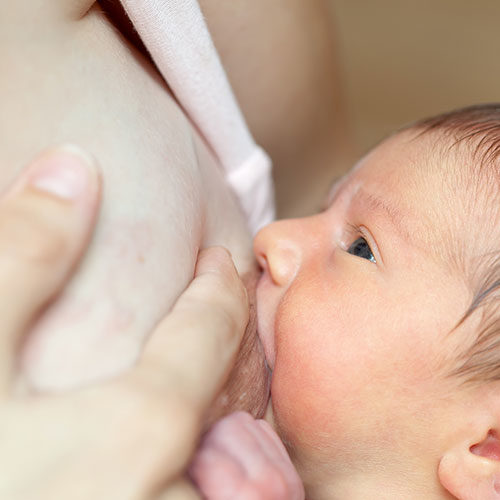C-section Births and Breastfeeding
As many of us have repeatedly heard, the type of birth can potentially affect the breastfeeding relationship and journey of a mother and her baby. Nowadays, an increasing number of women have started to prefer home births and natural (with no to limited medical interventions) births. However, C-section births are still widespread. Sometimes, they are elective, sometimes they are essential and sometimes they could be misguided or enforced. In any case, the breastfeeding journey that follows post childbirth needs some special care, attention and in some cases, intervention. Therefore, it’s important to educate oneself about them from before.
The effect of a C-section on Breastfeeding:
The impact that a C-section birth can have on breastfeeding is multifactorial. Below mentioned are some of the factors and specific concerns associated with C-section.
1. Anesthesia and other medication
● Anesthesia
Anesthesia given during the C-section should not affect the milk.
● Pain relievers
There are lots of breastfeeding friendly painkillers available which should be used. If there is excessive or more than required consumption of the pain relieving medicines, it can cause sleepiness not just in the mother but also in the baby, which can be a challenging situation in the first few days. Thus, it’s better to limit the usage of painkillers on a need basis.
2. Initiation of Breastfeeding
General Anesthesia is becoming less common with C-sections. Mother is awake during birth when spinal/epidural is administered. In such a case, the mother can nurse the baby right after birth. If the mother is under general anesthesia, it’s recommended to try to initiate breastfeeding as soon as the mother is conscious. It may not be possible to initiate breastfeeding within the first hour in that case. But it is recommended that it should be initiated within the first 4 hours of birth, latest.
3. Nursing Positions for C-section moms
There are a few positions that are very specifically compatible in case of C-section births. They are as follows..
● Baby on chest, across breasts
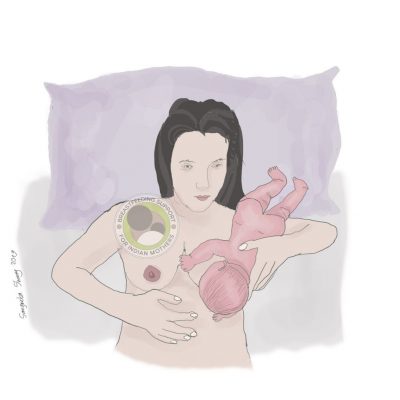
Image created by Sangeeta A Shenoy
In this position, the mother is lying down on her back and the baby is placed face down horizontally on the mother’s body i.e. across her breasts. This way, there’s no contact between the baby and the incision. This looks like a cradle position, but while lying down flat. It requires another person to support and hold the baby.
● Modified natural nursing position
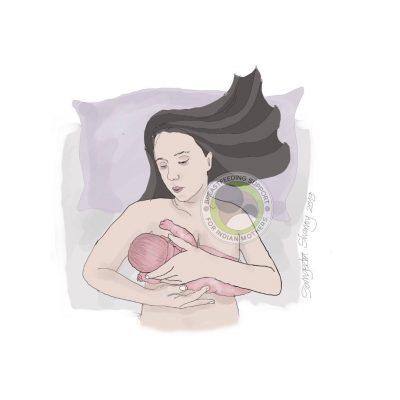
Image created by Sangeeta A Shenoy
This position is where the mother is lying down flat on her back while the baby is placed face down vertically on the mother’s body – but the feet of the baby are on the mother’s shoulders. This prevents any kicking to hurt the mother’s incision. This position is very useful in the first few hours to the first couple of days after birth. It requires another person’s help in holding the baby.
● Side lying position
This position is possible once the mother is able to turn over. It’s the common side lying position. But, it needs to be achieved with a lot of care and patience. The mother needs to turn over very slowly to avoid any kind of pressure on the abdomen. Lots of pillows can be used to support her back once she has turned. Pillows can be put between her legs too. The incision could be covered with pillows or a blanket in
order to avoid the baby’s kicks touching that part. Baby needs to be lying next to the mother, turned fully toward the mother and is pulled closer to the mother for latching.
● Football position
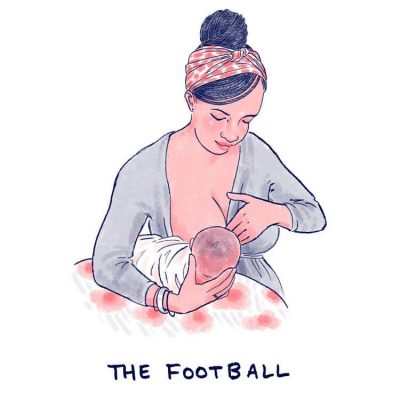
Image Source: https://www.mamanatural.com/breastfeeding-positions/
This position works once the mother is able to sit up and nurse. It prevents any contact between the baby and the incision. (Link to positions article)
● Additional position
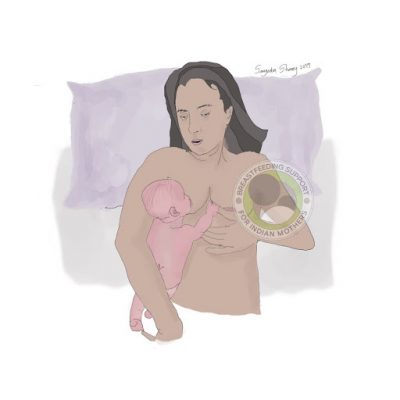
Image created by Sangeeta A Shenoy
4. Support System
A mother who has undergone a C-section usually needs more help and support from the partner in the initial days. This support is essential in holding and supporting the baby while nursing, providing support to the mother in getting to the nursing position and back to comfortably lying down, burping the baby, changing the baby and a lot of other things that the mother will be unable to do in the first few days. It is important to seek help from other family members or even hired help if required.
5. Milk Supply
There have been a lot of myths around C-section births and milk supply. A lot of women believe many of the following things –
-If the baby is born through C-section, the mother produces less milk.
-In case of a C-section, there’s no milk immediately after birth.
-In case of a C-section birth, it’s unavoidable to supplement with formula in order for the mother to get rest.
It’s important to realise that these are all myths. Milk production starts during pregnancy, so milk is definitely available immediately after birth. The hormonal changes that occur at the time of a vaginal birth (due to expulsion of placenta) also occur with C-section as the placenta and uterus are separated. Thus, the mother will have milk irrespective of the kind of birth she has. What may come into the picture in case of C-section births is – stress due to surgery, pain etc inhibiting the let down reflex. This slows down the milk ejection to some degree. But it has nothing to do with the actual supply. Some relaxation techniques like soft head/back massage, calming music, company of the supportive partner and other loved ones can work wonders.
Certain ideas to tackle any supply issues are as follows –
-Nurse often. Minimum 10-12 times in 24 hours.
-Nurse at the earliest hunger cues. Don’t wait for the baby to cry.
-Co-sleep with the baby and give unlimited access to the breasts.
-Avoid supplementing with breast milk substitutes.
Breastfeeding after a C-section birth can be challenging for the first few days or weeks. But with above discussed methods and strategies, it is absolutely possible to have a long and successful breastfeeding journey.
Wish to speak with a member of our team who is a certified lactation professional and also an experienced breastfeeding mother, click on this link.
Medical Advice Disclaimer
THIS WEBSITE DOES NOT PROVIDE MEDICAL ADVICE.
The information, including but not limited to, text, graphics, images and other material contained on this website are for informational purposes only. No material on this site is intended to be a substitute for professional medical advice, diagnosis or treatment. Always seek the advice of your physician or other qualified health care provider with any questions you may have regarding a medical condition or treatment before undertaking a new health care regimen, and never disregard professional medical advice or delay in seeking it because of something you have read on this website.
Disclaimer
We understand and acknowledge that parents and babies can be of various genders on a spectrum of LGBTQI+. Families come in diverse flavours. However, in our articles, for the sake of simplicity and convenience, we will be referring to the breastfeeding parent as the mother and using the female pronouns- ‘she’ and ‘her’ for babies. Babies can be nourished and nurtured in different ways and while we have used the terms breastfeeding and nursing, we recognize that parents can opt to chest feed or finger feed.
We don’t have conflicts of interest and declare, and we are compliant with the WHO code of marketing of breastmilk substitutes and the IMS act.
In case you find any information on this website that needs to be updated, please write to us at info@bsim.org.in




